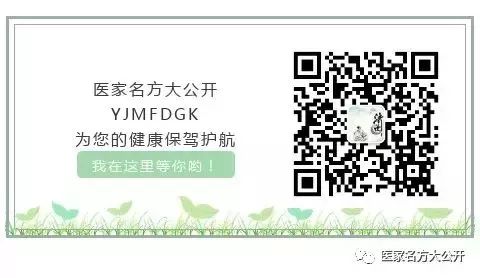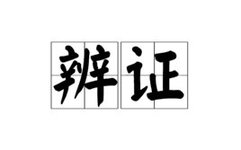New friends, click the blue text above “Famous Medical Formulas Revealed” to quickly follow us, and feel free to share!
We provide you with high-quality medical knowledge every day.
1. How to Differentiate Between Deficiency and Excess Patterns Clinically?
Deficiency and Excess: This primarily refers to the strength of the righteous (zheng) and evil (xie) forces.
Deficiency patterns indicate a deficiency of righteous qi, leading to insufficient resistance and susceptibility to external pathogens.
Excess patterns indicate a strong presence of pathogenic qi and intense struggle between the evil and righteous forces. In excess patterns, while the external pathogens overpower the body’s righteous qi, the righteous qi still has some strength to fight against the pathogens.

2. Characteristics of Deficiency Patterns:
1. Chronic illness often leads to deficiency; deficiency patterns generally occur after severe illnesses, with prolonged illness duration and difficulty in rapid recovery, making them prone to recurrence.
2. Due to insufficient righteous qi, the body’s response to disease may be subtle or not apparent, hence symptoms are not severe.
Symptoms include prolonged low fever, weight loss, spontaneous sweating, lack of energy, dull eyes, soft speech, long-term poor appetite, lingering abdominal pain, pale tongue with little coating, and weak, thin pulse.
3. Deficiency patterns often coexist with cold patterns (deficiency-cold patterns).
4. In cupping therapy for deficiency patterns, the cupping marks are generally not prominent, with the skin appearing light red or flushed.
Deficiency patterns can be further divided into qi deficiency, blood deficiency, yin deficiency, and yang deficiency, with the following clinical symptoms:
Qi Deficiency: Poor appetite, loose stools, abdominal distension, fatigue, edema, prolapse of the rectum, and even shortness of breath, reluctance to speak, and easy spontaneous sweating.
Blood Deficiency: Pale complexion, pale lips and nails, dizziness, palpitations, scanty and light menstrual flow in women after menstruation.
Yin Deficiency: Lower back and knee soreness, heat in the mouth, hands, feet, and heart, irritability, insomnia, night sweats, nocturnal emissions, dry eyes, dizziness, and tinnitus.
Yang Deficiency: Cold intolerance, cold limbs, soreness and weakness in the lower back and knees, cold pain, impotence, premature ejaculation, clear and thin vaginal discharge, increased nocturnal urination, and deep, weak pulse with a white coating.
3. Characteristics of Excess Patterns:
1. Acute illnesses are often excess; generally, the course of excess patterns is shorter, often belonging to the initial or middle stages of illness, with a more severe condition but usually quicker recovery.
2. Due to the intense struggle between the evil and righteous forces, the body’s response to the pathogenic factors is more pronounced, hence symptoms are more severe, such as high fever, absence of sweating, mental agitation, loud speech, abdominal pain with tenderness, constipation, short and red urine, severe cough with abundant phlegm, red tongue with yellow coating, and rapid, strong pulse.
Excess patterns often coexist with heat patterns (excess-heat patterns).
Any pathological foreign substances in the body (such as stones, tumors, blood stasis, ascites, phlegm, etc.) are classified as excess patterns.
In cupping therapy for excess patterns, the cupping marks are very prominent, often appearing bright red or purple, or may develop blisters.
Traditional Chinese Medicine (TCM) believes that the human body can be classified into two constitutions: “deficiency constitution” and “excess constitution.” Due to differences in innate basal metabolic rates, individuals with a lower basal metabolic rate or poor peripheral blood circulation may easily experience cold hands and feet in winter, indicating a “deficiency constitution.” Conversely, some individuals with a higher basal metabolic rate may have warm hands and feet but may also experience dryness and constipation due to “excess heat,” indicating an “excess constitution.”
The constitution being deficiency or excess primarily depends on genetic inheritance, as well as environmental factors, dietary habits, and health status. For instance, people from northern regions often appear robust, with a bright complexion and less fear of cold, while those from southern regions tend to have a deficiency constitution and are more sensitive to cold. Surveys have shown that the proportion of deficiency patterns among women is significantly higher than that among men, which is why more women tend to feel cold in winter.
To improve cold intolerance, parents should avoid overdressing their children from a young age; moderate clothing is sufficient to prevent overheating and sweating, which can lead to colds and loss of temperature adaptation. Healthy adults can start training by taking cold showers in summer, which over time can reduce sensitivity to cold, making it easier to resist cold in winter and less prone to colds. This training should be gradual, starting in warm weather; otherwise, sudden exposure to cold water or morning swimming may lead to accidents.
Many people find TCM theories confusing, especially concepts like qi, yin and yang, deficiency and excess. Today, I will explain what deficiency and excess mean. There are many explanations online, but they are often too professional for the average person to understand. Today, I will approach it from a perspective we can all understand.
First, let’s make a hypothetical scenario. Suppose there is a tribe where the ideal population is 20 people, with a perfect ratio of 10 men and 10 women. If the population exceeds 20 or the gender ratio is unbalanced, we say the tribe is “sick” and needs treatment.
In a simple assumption, if the population is too high, we call it excess; if the population is too low, we call it deficiency.
In the first scenario, if the tribe’s population increases to 25, with 10 women and 15 men, according to our previous assumption, the tribe is sick and needs treatment to restore it to its optimal state. Originally, there were 20 people, now there are 25, which is an excess of 5 people. To restore balance, we need to pair the 10 women with 10 men, leaving 5 men unpaired. The best solution is to remove the excess 5 men from the tribe. Without these 5 men, the tribe would consist of 10 women and 10 men, totaling 20 people, restoring the tribe’s health. The treatment method here was to eliminate the 5 excess men.
In the second scenario, if the tribe’s population decreases to 15, with 5 women and 10 men, according to our previous assumption, the tribe is still sick and needs treatment. Originally, there were 20 people, now there are 15, which is a deficiency of 5 people. After pairing, there are still 5 unpaired men. The best solution is to supplement the tribe with 5 women from outside, resulting in 10 women and 10 men, totaling 20 people, restoring normalcy. The treatment method here was to supplement the tribe with 5 women.
In both scenarios, there is a commonality: after pairing, there are still 5 unpaired men. If we do not differentiate between deficiency and excess, the surface symptoms appear the same. For example, in human illness, both may present with fever and vomiting, and if we do not discern the specific situation of deficiency or excess, using the same treatment method for both scenarios could lead to problems. In the first scenario, the 5 excess men are genuinely excessive; if we supplement with 5 women, the result would be 15 women and 15 men, which the tribe cannot sustain, leading to further issues. In the second scenario, the 5 excess men are not genuinely excessive; they are a result of the 5 missing women. If we simply eliminate the 5 excess men, the result would be 5 men and 5 women, totaling only 10 people, halving the tribe’s survival capacity. The gender imbalance issue is resolved, but other problems become more severe, potentially threatening survival. The illnesses are similar, both presenting with 5 excess men unpaired, but the treatment methods are entirely opposite. This is why TCM emphasizes the need to differentiate between deficiency and excess: excess requires elimination, while deficiency requires supplementation. This is reflected in the “Huangdi Neijing” (Yellow Emperor’s Inner Canon), which states: “For excess, drain it; for deficiency, tonify it.” Nowadays, many so-called TCM practitioners only recognize the disease, conducting tests and scans without considering deficiency and excess. They apply the same treatment for all similar diseases, leading to predictable results!
Now, let’s add another assumption: suppose men represent yang and women represent yin. I will discuss yin and yang in detail in future content! In the first scenario, the excess population is due to an excess of men, hence it is called yang excess or yang exuberance. In the second scenario, the deficiency is due to a lack of women, hence it is called yin deficiency.

The “Huangdi Neijing” states: “When evil qi is strong, it is excess; when essence qi is depleted, it is deficiency.” The 5 excess men in the first scenario are surplus compared to the normal population, representing evil qi. The 5 missing women in the second scenario represent the essence qi that should be present but is now depleted, hence it is called essence qi depletion leading to deficiency.
Based on the previous assumptions, we can derive several different deficiency and excess symptoms: if the number of men is normal and there are excess women, it is called yin excess or yin exuberance; if the number of women is normal and there are fewer men, it is called yang deficiency. If both men and women are in excess, it is called both excess, which is rarely seen in medical cases, but the “Huangdi Neijing” mentions it, stating that this situation leads to death if reversed and longevity if followed. This means that if the population increases and the ratio is coordinated, and other conditions are met, the tribe will thrive and its survival capacity will greatly increase, leading to longevity. However, if the population increases without sufficient resources, people will compete, potentially leading to self-destruction. If both men and women are lacking, it is called both yin and yang deficiency; if there are excess men and fewer women, it is called yang exuberance and yin deficiency; if there are fewer men and excess women, it is called yin exuberance and yang decline.
Having discussed all this, many people may say they understand the theory, but are unsure how to apply it in specific situations. Let me give an example. For instance, if one experiences excess heat, leading to dry mouth and tongue, why does this happen? It is due to an imbalance of yin and yang in the body. If one has consumed overly warming foods, leading to an excess of yang evil, we should take herbs that clear heat and reduce fire. If excessive sexual activity, physical exertion, or mental stress leads to depletion of yin fluids, we should supplement with herbs that generate fluids and nourish yin. If one continues to take herbs that clear heat and reduce fire in this case, it could lead to both yin and yang depletion. Additionally, if cold enters the body, restricting yin fluids, this should also be analyzed based on the cause of the deficiency, and warming methods should be applied!
Currently, why are so many people in sub-health conditions? Over 75% of Chinese people are in sub-health states, which ultimately, aside from environmental and dietary influences, is mainly due to treating diseases indiscriminately. Randomly prescribing TCM or Western medicine may superficially resolve issues, but the body is left to repair itself, which is often overwhelmed, leading to worsening conditions!
Warm reminder: The various prescriptions and remedies mentioned in this article are for reference and learning by professional TCM practitioners only and should not be used as prescriptions. Please do not self-medicate; this platform does not bear any responsibility for any consequences arising from such actions!
Copyright statement:
This article is sourced from the internet. We share articles and images from the internet, and the copyright belongs to the original authors and sources.


